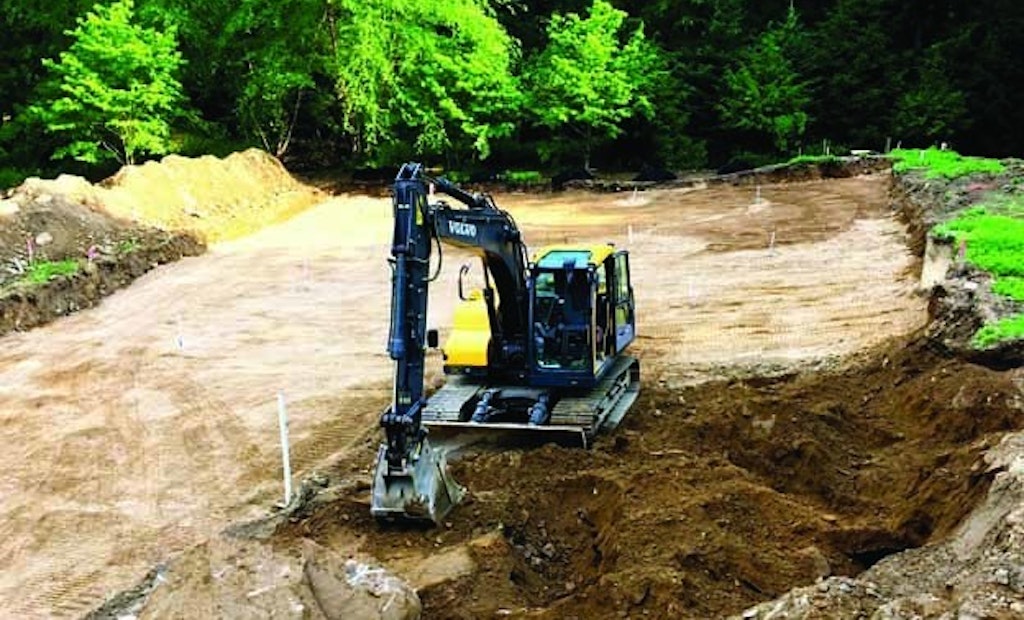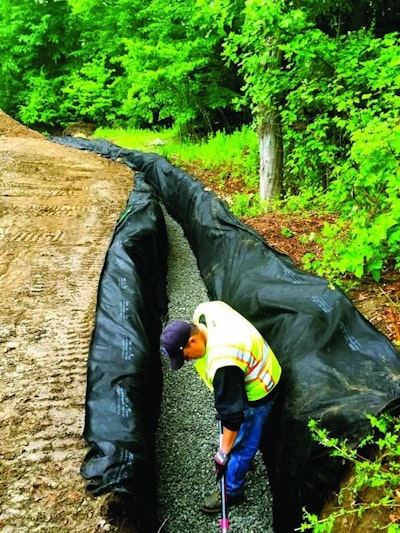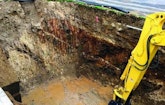
Interested in Septic Tanks?
Get Septic Tanks articles, news and videos right in your inbox! Sign up now.
Septic Tanks + Get AlertsPlans to enlarge the gymnasium at a private school in Greenwich, Connecticut, included three additional shower stalls.
A study of the ultrafiltration treatment plant and drainfield was a prerequisite to state and local approval of the system. The school manager hired Mark Lancor, P.E., principal engineer at DYMAR Corp. in Southbury, Connecticut, to provide the documentation and offer recommendations.
Drinking-water-quality permeate from the plant’s membrane bioreactor flushes bathroom fixtures, while excess treated water discharges to a low-pressure distribution sand filter. “The 2,310 gpd system was exceeding its discharge permit due to leaking fixtures, groundwater infiltration and runoff,” says Lancor. “That created a problem for the gymnasium project and future expansion.”
Lancor’s recommendations included a second equalization tank, a silt barrier and curtain drain up-gradient from the sand filter, and upgrading it for hydraulic buffering per the state’s request for improved efficiency. He also added a new programmable logic controller (PLC) to regulate process and dosing flows.
DYMAR’s design limited the school’s capital expense to $380,000 for the 6,600 gpd plant, as opposed to an estimated $1 million to add membranes and process tankage and enlarge the sand filter.
SYSTEM OPERATION
Wastewater gravity flows to the septic tank and 6,000-gallon equalization tank duplex pumps send effluent through a 2-inch Schedule 80 PVC force main to the ultrafiltration system, followed by UV disinfection. Permeate not used in lavatories flows to a dosing tank and is pumped to the 300- by 200-foot sand filter.
Liquid from three rows of gravelless chambers in the sand filter leaches down the sloped 140- by 80-foot-wide sand-and-gravel toe. No other discharge was possible because the absorption area is on bedrock/ledge covered with a geomembrane liner.
INFILTRATION PREVENTION
Mark Green, owner of Green Construction Management in Waterbury, Connecticut, won the bid. Together with his father, Wayne, and laborer Jovany Sandoval, they installed a double 225-foot-long silt fence separated by hay bales. It prevented runoff from reaching the sand filter.
As Mark Green dug the fence trenches with his Volvo EC140 excavator, he saw what looked like a rubber hose hanging from a nearby tree. “I knock it down with the bucket and this 5-foot-long black snake slithered away,” he says. “We found five or six snakes every day.”
Fifteen feet above the silt fence, the team excavated 4 feet to install the 400- by 3-foot curtain drain. After lining the trench from side to side with filter fabric, they added 4 inches of stone, laid 4-inch PVC pipe on top, covered it with 4 inches of stone and wrapped the fabric over it. They covered the bundle with another layer of fabric, then backfilled with gravel to grade.
“We laid 130 feet of perforated pipe followed by 175 feet of solid pipe discharging to the wetlands,” says Green. The installations took three days.
EFFICIENCY BOOSTER
Stripping the topsoil and 2 feet of fill off the sand filter toe presented challenges. The only area to stockpile the spoils was between the chambers and curtain drain. While Green exposed the septic gravel with the excavator, his dad transported 900 cubic yards of it up the slope in a Volvo MCT125C skid-steer loader.
“I couldn’t use a dump truck or push the spoils up the hill with a bulldozer because both would crush the chambers,” says Green. “The fill also contained rocks and boulders, including one too heavy to lift.” He rolled it out of the way with the bucket.
To improve the toe’s absorption rate, Lancor specified gravel with hydraulic conductivity (K value) of 8 to 15 feet per day. Green searched gravel pits in New York state and Connecticut without success. Then a friend on a job 24 miles away in Westport, Connecticut, hit the perfect bank run gravel.
“I had to install and compact it in two 12-inch lifts, 25 loads per lift, and we couldn’t use vibratory rollers because they compacted the gravel too quickly,” says Green. “The only way was to water and roll the stone repeatedly until it passed the test.” Unable to drive grade stakes without puncturing the drainfield’s liner, Green tied flags to PVC pipe mounted in composite boards.
SWITCHING GEARS
At this point, they excavated the hole for the equalization tank, needing the stockpiled soil to replace the rocks and boulders in the original fill.
Workers from Natural Systems Utilities (NSU), the plant operator, cut the section of sidewalk covering the location for the 7,500-gallon concrete EQ tank (Arrow Concrete Products). Vincent Noad of R V Noad Construction dug the 27- by 18- by 16-foot hole using a Kobelco 135 excavator.
Noad needed 5 feet between the original EQ tank and new one for the hydraulic core drill machine, and 4 feet of clearance on the opposite side. In addition, a 2-inch force main running from the wastewater treatment building to the drainfield passed through the excavation. Noad also couldn’t expand the width of the hole beyond 18 feet without taking out an electrical duct bank and half the parking lot.
“It was a one-shot deal,” says Green. “If Vinny dug too far back, he couldn’t go forward without falling in the hole.”
Luckily, the bucket hit water exactly at 16 feet — the seasonal high water level. Instead of needing a man in the pit with a laser level, Noad used the water. His driver hauled spoils to the stockpile in a tri-axle Sterling truck with Ox dump body. They bedded the hole with 12 inches of crushed stone and drew the tank’s outline on it to mark the exact position.
Meanwhile, Green’s crew placed 2 feet of fill over the gravel toe, then the topsoil. Randy Olmstead of All Green Hydroseed sprayed it with a custom mix of grass and wildflower hydroseeds. He eventually treated 26,000 square feet of disturbed area.
SETTING THE TANK
NSU hired a septic company to pump the septic tank and remain on standby all day. “The kids were on summer vacation, so there was barely any usage,” says Green. Nevertheless, he cut the force main and bypassed the flow around the work site.
A trucking company delivered the 75,950-pound EQ tank in two halves. A Quick Pick Crane set them using a Grove (Manitowac Crane) GMK5120B all-terrain hydraulic crane. The bottom section had a 14-inch stainless steel sleeve exactly 4 inches above the floor. It would house the 10-inch ductile iron pipe connecting both EQ tanks.
After setting the lower portion, Green used a laser to mark the location for the penetration into the original EQ tank. The bore went smoothly, but the floor of the new tank sloped toward the pipe, creating a lip that prevented Green from inserting the 7-foot-long pipe through the sleeve.
“The sleeves had to align perfectly, so it was with great reluctance that we lifted out the bottom half,” says Green. “We inserted the pipe into the existing tank’s sleeve, Quick Pick expertly reset the lower half, and we pulled in the pipe until it butted against the lip.”
Grout and Link-Seal couplings secured the pipes to the tank walls. Once the tank halves were mated, Green’s team applied a polyolefin-backed joint wrap (ConSeal - Concrete Sealants) around the seam to ensure watertightness.
While they bedded the pipes and backfilled with compacted bank run gravel around the tank, Green excavated and cut the recirculating force main. This enabled NSU to install a dosing manifold with ultrasonic level sensors and a magnetic flowmeter wire to the PLC.
To relocate the dosing force main, Green used a Volvo EC35C excavator to dig a 4-foot-deep trench, bedded it with 6 inches of compacted sand and laid new pipe. NSU installed a second identical manifold, and programmed the PLC to send 2,310 gpd to the sand filter. On low-flow days, it discharged excess treated water to the setpoint.
Tom Dauti, owner of Dauti Masonry, replaced the concrete sidewalk and extended a stone wall around the new EQ tank to retain the backfill. The upgrade was completed in a week and ahead of schedule, enabling the school to receive state and local approval.









